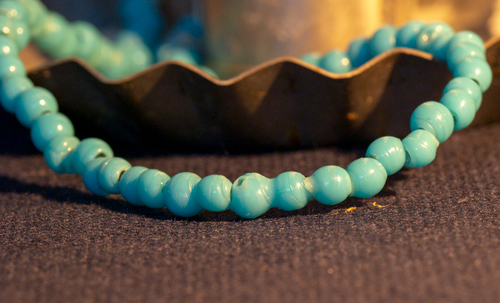Cheap Chinese Trade Beads (c. 1865)
© 2018 by Kristopher K. Townsend. Permission to use granted under the Creative Commons Attribution-Share Alike 4.0 International license.
Lewis’s preliminary list of supplies and equipment needed for the expedition, drawn up in the spring of 1803, included blue beads. “This is a coarse cheap bead,” he wrote, “imported from China, & costing in England 13 d. the lbs., in strands. It is far more valued than the white beads of the same manufacture and answers all the purposes of money, being counted by the fathom [six feet].”
His point was confirmed by 9 January 1806, when he wrote:
The natives are extravegantly fond of the most common cheap blue and white beads, of moderate size, or such that from 50 to 70 will weigh one penneyweight.[1]In troy weight—the standard in the Medieval French trading city of Troyes for measuring precious metals and the like—a pennyweight equals 24 grains, or 1/20 of an ounce. A troy pound equals 12 … Continue reading The blue is usually prefered to the white. These beads constitute the principal circulating medium with all the indian tribes on this river. For these beads they will dispose of any article they possess. The beads are strung on strands of a fathom in length and in that manner sold by the yard.
A few weeks later (19 March 1806) he added:
The favorite ornament of both sexes are the common coarse blue and white beads which the men wear tightly wound around their wrists and ankles many times untill they obtain the width of three or more inches. They also wear them in large rolls loosly around the neck, or pendulous from the cartelage of the nose or rims of the ears which are purforated for the purpose. The women wear them in a similar manner esxcept in the nose which they never purforate.
The Chinooks called blue beads tiaqmusaks, meaning “chief beads.”
Notes
| ↑1 | In troy weight—the standard in the Medieval French trading city of Troyes for measuring precious metals and the like—a pennyweight equals 24 grains, or 1/20 of an ounce. A troy pound equals 12 ounces. About how many of those beads of moderate size would there be in a troy pound? Goods such as sugar, salt, dyes, and grain were measured in avoirdupois weight (from French avoirdepois, or “goods of weight”). An avoirdupois pound contains 7,000 grains, or 16 ounces at 16 drams per ounce. An avoirdupois pound equals about 1.22 troy pounds. Then there was the stone, equal to 14 pounds, etc. Measurements of volume were even more complicated and confusing—the corn gallon, corn bushel, wine gallon, ale gallon, etc., etc. In short, weights and measurements in Lewis and Clark’s day were so complicated as to be practically meaningless. One of the most important outcomes of the French Revolution was the adoption, in 1799, of the simpler, logical, consistent metrical system of weights and measures, “for all people, for all time.” Yet it was not generally accepted in France until 1840. After that, it was taken up in Latin America, the Soviet Union, China, and Japan. The United States signed on, in principle, in 1875, but in the practical, everyday terms we are still weighed down by parts of the old systems. Meanwhile, a new International System of Units has replaced the “old” metric system. |
|---|
Experience the Lewis and Clark Trail
The Lewis and Clark Trail Experience—our sister site at lewisandclark.travel—connects the world to people and places on the Lewis and Clark Trail.
Discover More
- The Lewis and Clark Expedition: Day by Day by Gary E. Moulton (University of Nebraska Press, 2018). The story in prose, 14 May 1804–23 September 1806.
- The Lewis and Clark Journals: An American Epic of Discovery (abridged) by Gary E. Moulton (University of Nebraska Press, 2003). Selected journal excerpts, 14 May 1804–23 September 1806.
- The Lewis and Clark Journals. by Gary E. Moulton (University of Nebraska Press, 1983–2001). The complete story in 13 volumes.


